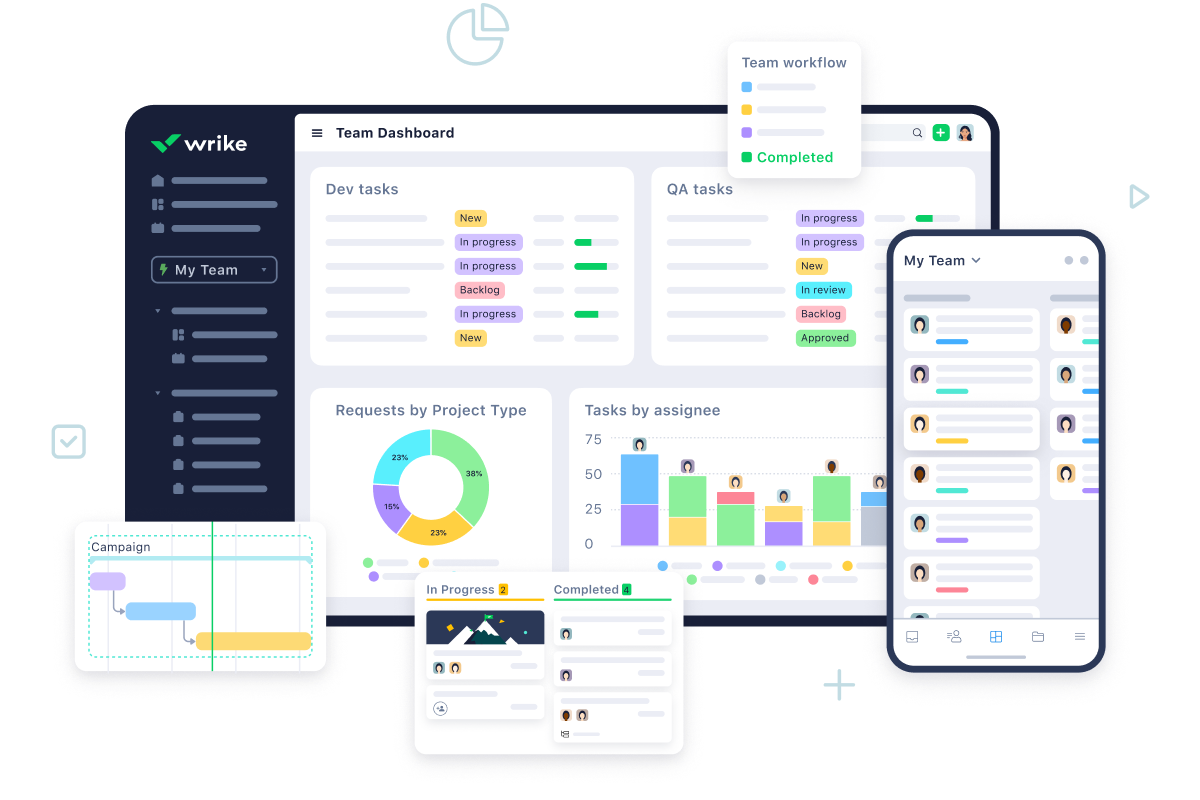Back to all comparisons
Clickup vs Wrike
Comprehensive comparison to help you choose the right tool for your needs

Clickup
4.7
ClickUp is a project management tool offering customizable task management and collaboration features, suitable for teams of all sizes.
Free Plan with basic features, Unlimited at $5/member/month, Business at $12, Business Plus at $19, and a custom-priced Enterprise Plan, each progressively offering more advanced features and functionalities
Visit Website 
Wrike
4.4
Wrike is a comprehensive project management tool offering workflow automation, data visualization, and collaboration features for teams.
Free, Professional at $9.80/user, Business at $24.80/user, and Enterprise. Each varies by features and team size
Visit Website Quick Summary
Clickup Strengths
- Real-time Collaboration: ClickUp supports team collaboration with features like a whiteboard, comments, chat, and more, enabling efficient real-time communication and idea sharing.
- Customizable Task Management (ClickApps): The platform offers a wide range of ClickApps, similar to add-ons, that allow users to tailor the task management experience to their specific needs, enhancing flexibility and organization.
- Diverse Viewing Options: Users can choose from various views like Calendar, Board, and Box, providing multiple perspectives for managing workspaces and tasks, ensuring that teams can work in the way that suits them best.
- Task Automation: Regular tasks can be automated in ClickUp, saving time and boosting productivity. This feature is especially beneficial for repetitive or routine tasks, streamlining workflow efficiency.
Wrike Strengths
- Interactive Gantt Charts: Wrike's Gantt charts allow users to visualize project timelines and dependencies. This feature helps in planning and adjusting schedules with simple drag-and-drop adjustments, facilitating easy management of complex project timelines.
- Real Time Collaboration: Teams can collaborate in real time, with updates and communications happening instantly across the platform. This ensures that all team members are on the same page and can react quickly to changes or updates.
- Customizable Dashboards: Wrike offers fully customizable dashboards that give users control over what data they see and how it's presented. This helps in tracking the most relevant project metrics and individual tasks, tailoring the view to meet specific needs or roles within a team.
- Integrated Resource Management: The software includes tools for resource allocation and management, allowing managers to oversee team workloads, plan capacity, and distribute tasks efficiently to avoid overloading employees.
Clickup Screenshot

Wrike Screenshot

Feature Comparison
| Feature | Clickup | Wrike |
|---|---|---|
| Platforms | macOS, iOS, Android, Web, Windows | Yes |
| Integrations | Gmail, Zoom, Harvest Time Tracking, Unito, Slack, Make, PomoDone, TimeCamp, Time Doctor, LambdaTest, DueFocus, and Twilio | Salesforce, Microsoft Teams, Google Drive, Slack, Adobe Creative Cloud, and Zoom |
| Calendar | Yes | Yes |
| Task Management | Labels, tags, recurring tasks, checklists, and task dependencies | Task Creation and Updating, Multiple Viewing Options, Time Tracking, Templates, Comprehensive Task Reports, Task history logging, File Uploads and Sharing capabilities |
| Natural Language Processing | Not mentioned | No |
| Analytics | Yes | Yes |
| Time Blocking | No | Yes |
| Time Zones | Yes | Yes |
| Scheduler | ClickUp integrates with scheduling tools like Google Calendar but does not have a native meeting scheduler. | Yes |
| Notifications | Yes | Yes |
| Pricing | Free Plan with basic features, Unlimited at $5/member/month, Business at $12, Business Plus at $19, and a custom-priced Enterprise Plan, each progressively offering more advanced features and functionalities | Free, Professional at $9.80/user, Business at $24.80/user, and Enterprise. Each varies by features and team size |
| Customer Support | Average | Good |
Video Overview
Clickup Video
Wrike Video
Clickup Overview
ClickUp is a project management software that stands out for its customizability and flexibility. It's designed to accommodate both small and large teams, offering an all-in-one productivity tool for effective collaboration and time management. ClickUp is praised for its hierarchy system that includes spaces, folders, and lists, enhancing task organization and real-time communication through comments and chats. It offers a variety of views like Calendar, Board, and Box, along with real-time collaboration features, task automation, and an extensive range of ClickApps for customization.
Pricing Details
ClickUp's pricing plans include: (i) Free Plan: Offers essential features for simple task management. (ii) Unlimited Plan: $5 per member/month, billed annually, for unlimited tasks, integrations, and dashboards. (iii) Business Plan: $12 per member/month, billed annually, includes advanced features for mid-sized teams. (iv) Business Plus Plan: $19 per member/month, billed annually, ideal for multiple teams. (v) Enterprise Plan: Custom pricing, offering advanced security and control for large organizations.
Wrike Overview
Wrike is a project management software designed to help teams manage their workspace and projects more efficiently. It offers a traditional interface with a wide range of functionalities including tables, boards, Gantt charts, and templates for collaboration across remote, hybrid, and in-person teams. Wrike supports various types of file proofing and integrates well with other tools like Miro, Microsoft Teams, and Slack. It is particularly popular among marketing and sales teams for its resource management and time logging features.
Pricing Details
Wrike offers several pricing plans based on the size and needs of teams. Here's a brief overview: (i) Free Plan: Designed for teams just starting out, offering basic project management features with limitations on active tasks. (ii) Professional Plan: Costs $9.80 per user/month, suitable for teams of 2-25 users, offering unlimited projects, tasks, and 2 GB of storage per user. (iii) Business Plan: Priced at $24.80 per user/month, tailored for larger teams, it includes comprehensive project management tools, automation, approvals, and 5 GB of storage per user. (iv) Enterprise Plan: For large teams needing enterprise-grade security and scalability, with pricing available upon contact. It includes advanced security features, automation, and 10 GB of storage per user. (v) Pinnacle Plan: Aimed at teams with complex work needs, offering advanced analytics, 15 GB of storage per user, and premium features, with pricing available upon request.
Clickup Key Features
Real-time Collaboration: ClickUp supports team collaboration with features like a whiteboard, comments, chat, and more, enabling efficient real-time communication and idea sharing.
Customizable Task Management (ClickApps): The platform offers a wide range of ClickApps, similar to add-ons, that allow users to tailor the task management experience to their specific needs, enhancing flexibility and organization.
Diverse Viewing Options: Users can choose from various views like Calendar, Board, and Box, providing multiple perspectives for managing workspaces and tasks, ensuring that teams can work in the way that suits them best.
Task Automation: Regular tasks can be automated in ClickUp, saving time and boosting productivity. This feature is especially beneficial for repetitive or routine tasks, streamlining workflow efficiency.
Comprehensive Dashboard: ClickUp's dashboard provides a clear overview of projects, including task tracking, goal setting, and team performance insights, helping in effective project management and decision-making.
Time Tracking Tools: The platform includes time tracking tools that allow for setting estimated times for tasks, aiding in better time management and resource allocation within teams.
Wrike Key Features
Interactive Gantt Charts: Wrike's Gantt charts allow users to visualize project timelines and dependencies. This feature helps in planning and adjusting schedules with simple drag-and-drop adjustments, facilitating easy management of complex project timelines.
Real Time Collaboration: Teams can collaborate in real time, with updates and communications happening instantly across the platform. This ensures that all team members are on the same page and can react quickly to changes or updates.
Customizable Dashboards: Wrike offers fully customizable dashboards that give users control over what data they see and how it's presented. This helps in tracking the most relevant project metrics and individual tasks, tailoring the view to meet specific needs or roles within a team.
Integrated Resource Management: The software includes tools for resource allocation and management, allowing managers to oversee team workloads, plan capacity, and distribute tasks efficiently to avoid overloading employees.
Advanced Security Features: Wrike provides robust security measures, including role-based access control, to ensure that sensitive project data is protected and only accessible to authorized personnel.
Automation Tools: With Wrike, repetitive tasks can be automated using custom workflows, which saves time and reduces the potential for human error. This feature supports a smoother project flow and improves overall efficiency.
Conclusion: Which Tool Should You Choose?
Both Clickup and Wrike offer unique features and benefits for productivity and workflow management. The best choice depends on your specific needs, team size, and workflow preferences.
Choose Clickup if:
- Real-time Collaboration: ClickUp supports team collaboration with features like a whiteboard, comments, chat, and more, enabling efficient real-time communication and idea sharing.
- Customizable Task Management (ClickApps): The platform offers a wide range of ClickApps, similar to add-ons, that allow users to tailor the task management experience to their specific needs, enhancing flexibility and organization.
- Diverse Viewing Options: Users can choose from various views like Calendar, Board, and Box, providing multiple perspectives for managing workspaces and tasks, ensuring that teams can work in the way that suits them best.
Choose Wrike if:
- Interactive Gantt Charts: Wrike's Gantt charts allow users to visualize project timelines and dependencies. This feature helps in planning and adjusting schedules with simple drag-and-drop adjustments, facilitating easy management of complex project timelines.
- Real Time Collaboration: Teams can collaborate in real time, with updates and communications happening instantly across the platform. This ensures that all team members are on the same page and can react quickly to changes or updates.
- Customizable Dashboards: Wrike offers fully customizable dashboards that give users control over what data they see and how it's presented. This helps in tracking the most relevant project metrics and individual tasks, tailoring the view to meet specific needs or roles within a team.